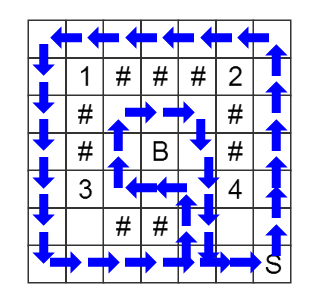我是靠谱客的博主 能干酸奶,这篇文章主要介绍Codeforces Round #221 (Div. 2) E. Circling Round Treasures (搜索+判断点在多边形内),现在分享给大家,希望可以做个参考。
题意:
给你一个地图,上面有一些宝石、炸弹,让你从一个点出发回到这个点,使圈起来的宝石的价值-步数最大,并且不能圈到炸弹,能够圈到‘#’,一个点允许重复走。
思路:
就是 poj3182 的加强版,建议先做这个题,可以参考:poj 3182 题解
预处理每个圈住宝石的状态的价值,炸弹可当做价值为负无穷的宝石,取dp[x][y][k]判重,x、y为位置,k为圈住宝石的状态,剩下的就是怎样判断一个路径圈住宝石的状态了,方法是过点做一条射线,这个射线与多边形交奇数次为在多边形内,偶数次则为多边形外,具体操作只需要虚拟的射线就够了。
代码:
#include <iostream>
#include <cstdio>
#include <cstring>
#include <algorithm>
#include <cmath>
#include <string>
#include <map>
#include <stack>
#include <vector>
#include <set>
#include <queue>
//#pragma comment (linker,"/STACK:102400000,102400000")
#define maxn 25
#define mod 1000000007
#define INF 0x3f3f3f3f
#define OO 0xbfbfbfbf
using namespace std;
typedef long long ll;
int n,m,ans,cnt,flag,tot;
int sx,sy;
int dx[]= {-1,1,0,0};
int dy[]= {0,0,-1,1};
int dp[maxn][maxn][1<<8];
int val[8],w[1<<8];
int gx[8],gy[8];
char mp[maxn][maxn];
char s[maxn];
struct Node
{
int x,y,k;
} cur,now;
bool issur(int nx,int ny,int tx,int ty,int j)
{
if(nx==gx[j]&&ny<gy[j])
{
if(tx<gx[j]) return true ;
}
else if(tx==gx[j]&&ty<gy[j])
{
if(nx<gx[j]) return true ;
}
return false ;
}
void bfs()
{
int i,j,t,k,nx,ny,tx,ty,nk;
queue<Node>q;
memset(dp,-1,sizeof(dp));
ans=-INF;
cur.x=sx;
cur.y=sy;
cur.k=0;
dp[sx][sy][0]=0;
q.push(cur);
while(!q.empty())
{
now=q.front();
q.pop();
nx=now.x;
ny=now.y;
nk=now.k;
if(nx==sx&&ny==sy) ans=max(ans,w[nk]-dp[nx][ny][nk]);
for(i=0; i<4; i++)
{
tx=nx+dx[i];
ty=ny+dy[i];
k=nk;
if(tx<1||tx>n||ty<1||ty>m) continue ;
if(!(mp[tx][ty]=='S'||mp[tx][ty]=='.')) continue ;
for(j=0;j<=cnt;j++)
{
if(issur(nx,ny,tx,ty,j)) k^=(1<<j);
}
if(dp[tx][ty][k]!=-1&&dp[tx][ty][k]<=dp[nx][ny][nk]+1) continue ;
cur.x=tx;
cur.y=ty;
cur.k=k;
dp[tx][ty][k]=dp[nx][ny][nk]+1;
q.push(cur);
}
}
}
int main()
{
int i,j,t;
while(~scanf("%d%d",&n,&m))
{
cnt=-1;
for(i=1; i<=n; i++)
{
scanf("%s",s);
for(j=1; j<=m; j++)
{
mp[i][j]=s[j-1];
if(mp[i][j]=='S') sx=i,sy=j;
if(mp[i][j]>='1'&&mp[i][j]<='8')
{
t=mp[i][j]-'1';
cnt++;
gx[t]=i,gy[t]=j;
}
}
}
for(i=0;i<=cnt;i++)
{
scanf("%d",&val[i]);
}
for(i=1; i<=n; i++)
{
for(j=1; j<=m; j++)
{
if(mp[i][j]=='B') gx[++cnt]=i,gy[cnt]=j,val[cnt]=-10000;
}
}
memset(w,0,sizeof(w));
tot=1<<(cnt+1);
for(i=0;i<tot;i++)
{
for(j=0;j<=cnt;j++)
{
if(i&(1<<j)) w[i]+=val[j];
}
}
bfs();
printf("%dn",ans);
}
return 0;
}
/*
3 3
...
SB.
...
10 11
........S..
...........
5........1.
.7#........
...64.#....
...........
..........#
.2.........
.....3.....
...........
-9
33
9
-20
12
10
-29
ans:0 8
*/
最后
以上就是能干酸奶最近收集整理的关于Codeforces Round #221 (Div. 2) E. Circling Round Treasures (搜索+判断点在多边形内)的全部内容,更多相关Codeforces内容请搜索靠谱客的其他文章。
本图文内容来源于网友提供,作为学习参考使用,或来自网络收集整理,版权属于原作者所有。










发表评论 取消回复